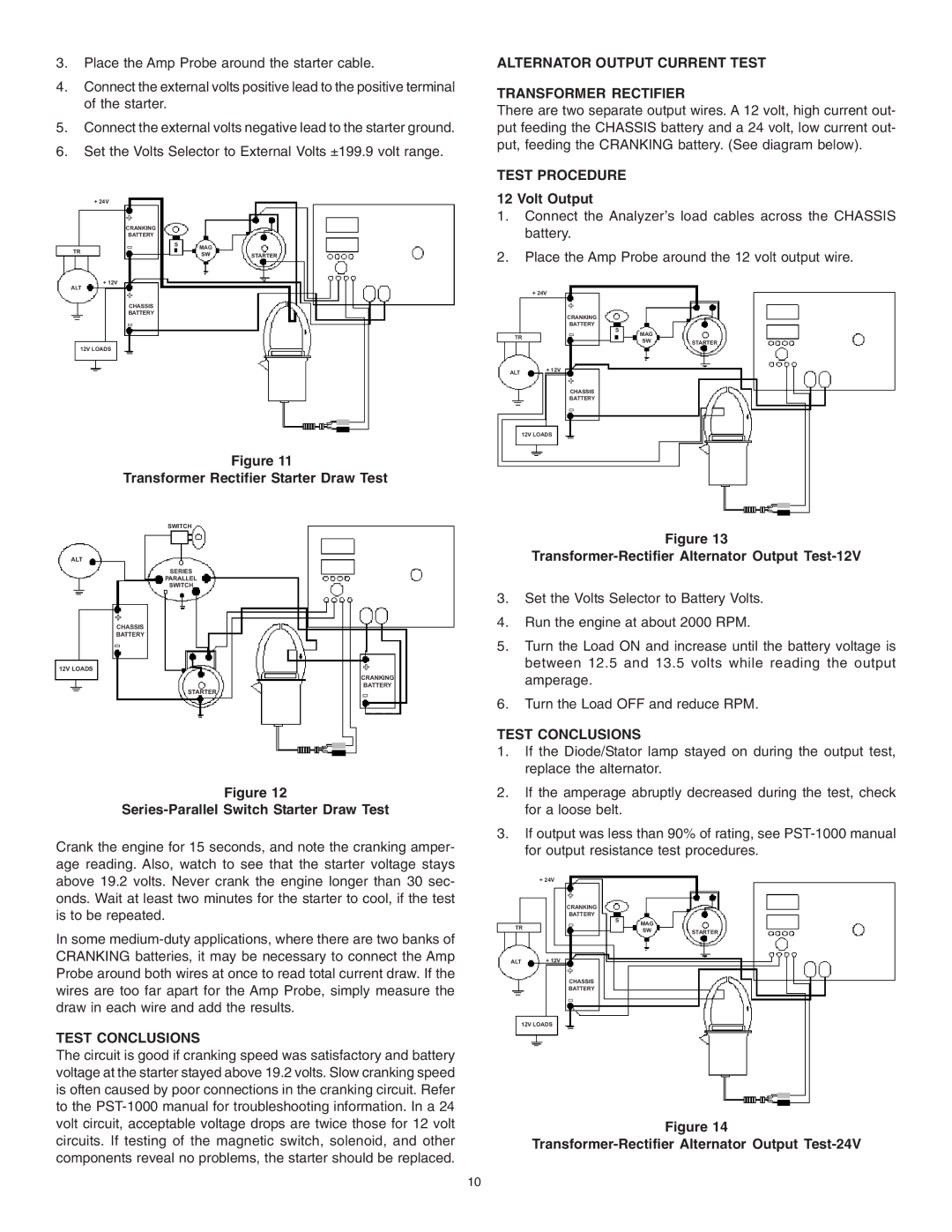
3.Place the Amp Probe around the starter cable.
4.Connect the external volts positive lead to the positive terminal of the starter.
5.Connect the external volts negative lead to the starter ground.
6.Set the Volts Selector to External Volts ±199.9 volt range.
+ 24V
+
CRANKING
| BATTERY |
|
|
|
| - | S | MAG |
|
TR |
|
| ||
|
| SW | STARTER | |
|
|
|
+ 12V
ALT
+
CHASSIS
BATTERY
-
12V LOADS
Figure 11
Transformer Rectifier Starter Draw Test
SWITCH
ALT
SERIES
PARALLEL
SWITCH
+
CHASSIS BATTERY
-
12V LOADS | + |
CRANKING
BATTERY
STARTER | - |
Figure 12
Series-Parallel Switch Starter Draw Test
Crank the engine for 15 seconds, and note the cranking amper- age reading. Also, watch to see that the starter voltage stays above 19.2 volts. Never crank the engine longer than 30 sec- onds. Wait at least two minutes for the starter to cool, if the test is to be repeated.
In some
TEST CONCLUSIONS
The circuit is good if cranking speed was satisfactory and battery voltage at the starter stayed above 19.2 volts. Slow cranking speed is often caused by poor connections in the cranking circuit. Refer to the
ALTERNATOR OUTPUT CURRENT TEST
TRANSFORMER RECTIFIER
There are two separate output wires. A 12 volt, high current out- put feeding the CHASSIS battery and a 24 volt, low current out- put, feeding the CRANKING battery. (See diagram below).
TEST PROCEDURE
12 Volt Output
1.Connect the Analyzer’s load cables across the CHASSIS battery.
2.Place the Amp Probe around the 12 volt output wire.
| + 24V |
|
| + |
|
| CRANKING |
|
| BATTERY |
|
TR | - | S |
MAG |
| SW | STARTER |
ALT | + 12V |
|
|
| |
| + |
|
| CHASSIS |
|
| BATTERY |
|
| - |
|
| 12V LOADS |
|
Figure 13
Transformer-Rectifier Alternator Output Test-12V
3.Set the Volts Selector to Battery Volts.
4.Run the engine at about 2000 RPM.
5.Turn the Load ON and increase until the battery voltage is between 12.5 and 13.5 volts while reading the output amperage.
6.Turn the Load OFF and reduce RPM.
TEST CONCLUSIONS
1.If the Diode/Stator lamp stayed on during the output test, replace the alternator.
2.If the amperage abruptly decreased during the test, check for a loose belt.
3.If output was less than 90% of rating, see
| + 24V |
|
|
|
| + |
|
|
|
| CRANKING |
|
|
|
| BATTERY |
|
|
|
TR | - | S | MAG |
|
|
| |||
|
|
| SW | STARTER |
|
|
|
| |
ALT | + 12V |
|
|
|
| + |
|
|
|
| CHASSIS |
|
|
|
| BATTERY |
|
|
|
| - |
|
|
|
12V LOADS
Figure 14
10
